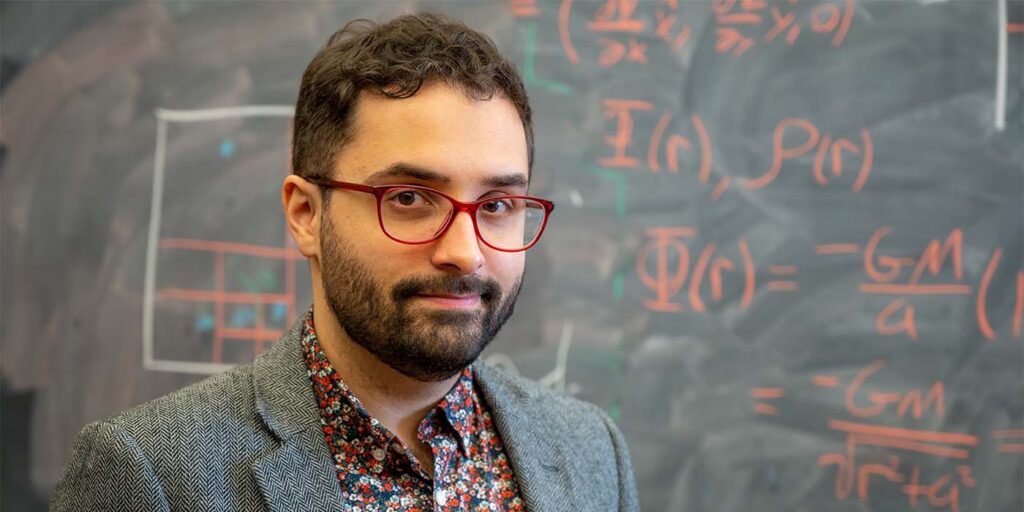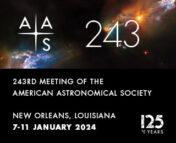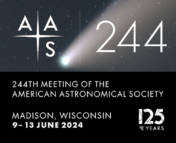In this series of posts, we sit down with a few of the keynote speakers of the 244th AAS meeting to learn more about them and their research. You can see a full schedule of their talks here, and read our other interviews here!
Globular clusters are the densest stellar environments in the universe. They are also suspected “black hole mosh pits,” as Dr. Carl Rodriguez once said in a 2017 interview. Compared to isolated binaries, dynamical encounters within globular clusters are expected to significantly increase the binary black hole (BBH) merger rate. Here on Earth, we detect these energetic events as gravitational waves, which can tell us about the mass and approximate distance of a given BBH merger.
Dr. Rodriguez is currently a professor at the University of North Carolina Chapel Hill, where he leads the stellar dynamics, stellar evolution, black holes, and gravitational waves group. He is also the recipient of the 2024 Helen B. Warner Prize for Astronomy for “fundamental advances on the astrophysical origin of gravitational-wave sources.” His prize talk, titled “The Lives and Deaths of Star Clusters, and the Black Holes they Make Along the Way,” will be an overview of the past few years of his career, during which he has focused on building N-body simulations of globular clusters to determine how crowded cluster environments contribute to the galaxy’s BBH population.

Dr. Rodriguez credits his interest in gravitational-wave sources to the University of Florida’s physics REU program, which he participated in as a junior in college. “I applied to [the program] having very little background in gravitational waves,” he said, and no background in programming. “My mentor for that REU gave me a slightly overambitious bit of prep work … ‘Why don’t you learn the programming language C and write up a gravitational wave generator before you get here?’” The experience led Dr. Rodriguez to fall in love with computational physics. He applied for PhD programs the following fall, only considering schools with LIGO groups, and enrolled at Northwestern University in 2010.
As a graduate student, Dr. Rodriguez worked on extracting physical parameters from gravitational wave signals before switching to computational stellar dynamics. It wasn’t until the final year of his PhD that he decided to merge the two topics. At the time, predictions for LIGO’s BBH merger detection rate usually did not include mergers caused by dynamical interactions in globular clusters. The few studies that had considered dynamics did not account for how sensitive the detectors would be to massive BBHs. To address this, Dr. Rodriguez simulated 48 globular clusters and studied how cluster properties were related to the number of BBH mergers that occurred during the simulations.
He published his results in July 2015. Just two months later, LIGO detected the first ever gravitational wave signal, GW150914. Analysis of the signal revealed the progenitors to be black holes of around 30 M☉ each – a system that aligned perfectly with Dr. Rodriguez’s predictions for dynamical mergers. In his simulations, BBHs with an effective mass of greater than 13 M☉ only merged through dynamical interactions. “That got a fair bit of attention,” he said. “It sort of cemented these dynamical formation processes as a valid [BBH] merger channel.”
During his postdoc years, Dr. Rodriguez focused on improving his simulations, publishing updated results in April 2018. “We looked further into the models and added relativistic corrections to the equations of motion,” he said. Before including these corrections, BBHs were often ejected from their simulated clusters when their progenitor stars collapsed, delaying their merger by several gigayears. After the corrections, the number of mergers that occurred within clusters increased significantly. The products of these mergers sometimes even merged with each other, creating a second generation of black holes in a process known as “hierarchical mergers.”
This was an exciting breakthrough, Dr. Rodriguez explained, because these second-generation black holes “[could] have masses beyond what we think you can form through stellar evolution.” Though the upper limit on stellar-mass black holes isn’t precisely known, accepted values typically range from 50 to 65 M☉. Detecting a black hole larger than that would mean either that our understanding of stellar evolution is incorrect, or that other processes (like dynamical interactions in clusters!) play an important role in black hole formation.
The astronomical community didn’t have to wait long. On September 2, 2020, LIGO announced the detection of BBH merger GW190521. Its progenitors were 85 and 66 M☉, respectively – “masses around what you would expect from a hierarchical merger scenario,” Dr. Rodriguez said. The merger product, which clocked in at a whopping 142 M☉, remains the largest LIGO has ever detected.
Now, as a new faculty member at UNC Chapel Hill, Dr. Rodriguez is expanding his research focus. He’s still excited about BBHs, especially after the Gaia Collaboration announced the discovery of a 33 M☉ black hole with a main sequence binary companion in April 2024. “It’s in the middle of a stellar stream that we think is a disrupted globular cluster,” he said, which would provide direct evidence for the theoretical predictions in his 2015 paper. But he has also started thinking more deeply about galactic dynamics, stellar streams, and massive star evolution. “As faculty … you get to hire people with expertise that is pretty far outside your own,” he explained. “It’s been very fun getting to build a group of people that know a lot of things that I don’t about, for example, stellar evolution or the very technical details of star cluster and stellar dynamics.”
Dr. Rodriguez’s advice to early career students is to take advantage of graduate school to experiment with projects in a variety of subfields. “Just because you’ve decided you want to try something doesn’t mean you’re locked into it,” he said. “Be okay trying a few different things and admitting, ‘This is something I really want to do!’ or, ‘I tried this, and it’s objectively cool, but maybe not for me.’ If you’re going to spend a significant amount of your life working on something … you want to be sure you’ll enjoy it.”
To hear more about the role of dynamical interactions in creating gravitational-wave sources, tune into Dr. Rodriguez’s plenary lecture at 8:00 AM CT on Wednesday, June 12, 2024 at #AAS244!
Edited by: Jessie Thwaites
Featured Image Credit: AAS


